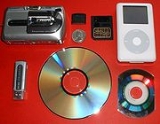
Data storage device
Encyclopedia
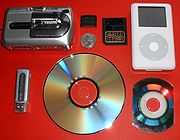
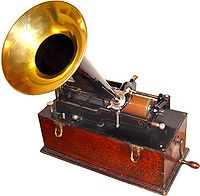
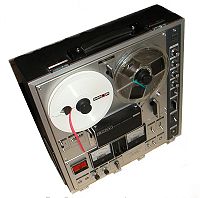


Recording
Recording is the process of capturing data or translating information to a recording format stored on some storage medium, which is often referred to as a record or, if an auditory medium, a recording....
(storing) information
Information
Information in its most restricted technical sense is a message or collection of messages that consists of an ordered sequence of symbols, or it is the meaning that can be interpreted from such a message or collection of messages. Information can be recorded or transmitted. It can be recorded as...
(data). Recording
Recording
Recording is the process of capturing data or translating information to a recording format stored on some storage medium, which is often referred to as a record or, if an auditory medium, a recording....
can be done using virtually any form of energy
Energy
In physics, energy is an indirectly observed quantity. It is often understood as the ability a physical system has to do work on other physical systems...
, spanning from manual muscle power in handwriting
Handwriting
Handwriting is a person's particular & individual style of writing with pen or pencil, which contrasts with "Hand" which is an impersonal and formalised writing style in several historical varieties...
, to acoustic vibrations in phonograph
Phonograph
The phonograph record player, or gramophone is a device introduced in 1877 that has had continued common use for reproducing sound recordings, although when first developed, the phonograph was used to both record and reproduce sounds...
ic recording, to electromagnetic energy modulating magnetic tape
Magnetic tape
Magnetic tape is a medium for magnetic recording, made of a thin magnetizable coating on a long, narrow strip of plastic. It was developed in Germany, based on magnetic wire recording. Devices that record and play back audio and video using magnetic tape are tape recorders and video tape recorders...
and optical disc
Optical disc
In computing and optical disc recording technologies, an optical disc is a flat, usually circular disc which encodes binary data in the form of pits and lands on a special material on one of its flat surfaces...
s.
A storage device may hold information, process information, or both. A device that only holds information is a recording medium. Devices that process information (data storage equipment) may either access a separate portable (removable) recording medium or a permanent component to store and retrieve information.
Electronic data storage is storage which requires electrical power to store and retrieve that data. Most storage devices that do not require vision
Visual perception
Visual perception is the ability to interpret information and surroundings from the effects of visible light reaching the eye. The resulting perception is also known as eyesight, sight, or vision...
and a brain to read data fall into this category. Electromagnetic data may be stored in either an analog
Analog signal
An analog or analogue signal is any continuous signal for which the time varying feature of the signal is a representation of some other time varying quantity, i.e., analogous to another time varying signal. It differs from a digital signal in terms of small fluctuations in the signal which are...
or digital
Digital
A digital system is a data technology that uses discrete values. By contrast, non-digital systems use a continuous range of values to represent information...
format on a variety of media. This type of data is considered to be electronically encoded data, whether or not it is electronically stored in a semiconductor
Semiconductor
A semiconductor is a material with electrical conductivity due to electron flow intermediate in magnitude between that of a conductor and an insulator. This means a conductivity roughly in the range of 103 to 10−8 siemens per centimeter...
device, for it is certain that a semiconductor device was used to record it on its medium. Most electronically processed data storage media (including some forms of computer data storage) are considered permanent (non-volatile) storage, that is, the data will remain stored when power is removed from the device. In contrast, most electronically stored information within most types of semiconductor (computer chips) microcircuits are volatile memory
Volatile memory
Volatile memory, also known as volatile storage, is computer memory that requires power to maintain the stored information, unlike non-volatile memory which does not require a maintained power supply...
, for it vanishes if power is removed.
With the exception of barcode
Barcode
A barcode is an optical machine-readable representation of data, which shows data about the object to which it attaches. Originally barcodes represented data by varying the widths and spacings of parallel lines, and may be referred to as linear or 1 dimensional . Later they evolved into rectangles,...
s and OCR
Optical character recognition
Optical character recognition, usually abbreviated to OCR, is the mechanical or electronic translation of scanned images of handwritten, typewritten or printed text into machine-encoded text. It is widely used to convert books and documents into electronic files, to computerize a record-keeping...
data, electronic data storage is easier to revise and may be more cost effective than alternative methods due to smaller physical space requirements and the ease of replacing (rewriting) data on the same medium. However, the durability of methods such as printed data is still superior to that of most electronic storage media. The durability limitations may be overcome with the ease of duplicating (backing-up
Backup
In information technology, a backup or the process of backing up is making copies of data which may be used to restore the original after a data loss event. The verb form is back up in two words, whereas the noun is backup....
) electronic data.
Terminology
Devices that are not used exclusively for recording (e.g. handHand
A hand is a prehensile, multi-fingered extremity located at the end of an arm or forelimb of primates such as humans, chimpanzees, monkeys, and lemurs...
s, mouth
Mouth
The mouth is the first portion of the alimentary canal that receives food andsaliva. The oral mucosa is the mucous membrane epithelium lining the inside of the mouth....
s, musical instrument
Musical instrument
A musical instrument is a device created or adapted for the purpose of making musical sounds. In principle, any object that produces sound can serve as a musical instrument—it is through purpose that the object becomes a musical instrument. The history of musical instruments dates back to the...
s) and devices that are intermediate in the storing/retrieving process (e.g. eyes
Human eye
The human eye is an organ which reacts to light for several purposes. As a conscious sense organ, the eye allows vision. Rod and cone cells in the retina allow conscious light perception and vision including color differentiation and the perception of depth...
, ear
Ear
The ear is the organ that detects sound. It not only receives sound, but also aids in balance and body position. The ear is part of the auditory system....
s, camera
Camera
A camera is a device that records and stores images. These images may be still photographs or moving images such as videos or movies. The term camera comes from the camera obscura , an early mechanism for projecting images...
s, scanner
Image scanner
In computing, an image scanner—often abbreviated to just scanner—is a device that optically scans images, printed text, handwriting, or an object, and converts it to a digital image. Common examples found in offices are variations of the desktop scanner where the document is placed on a glass...
s, microphone
Microphone
A microphone is an acoustic-to-electric transducer or sensor that converts sound into an electrical signal. In 1877, Emile Berliner invented the first microphone used as a telephone voice transmitter...
s, speaker
Loudspeaker
A loudspeaker is an electroacoustic transducer that produces sound in response to an electrical audio signal input. Non-electrical loudspeakers were developed as accessories to telephone systems, but electronic amplification by vacuum tube made loudspeakers more generally useful...
s, monitor
Display device
A display device is an output device for presentation of information in visual or tactile form...
s, video projector
Video projector
A video projector is an image projector that receives a video signal and projects the corresponding image on a projection screen using a lens system. All video projectors use a very bright light to project the image, and most modern ones can correct any curves, blurriness, and other...
s) are not usually considered storage devices. Devices that are exclusively for recording (e.g. printer
Computer printer
In computing, a printer is a peripheral which produces a text or graphics of documents stored in electronic form, usually on physical print media such as paper or transparencies. Many printers are primarily used as local peripherals, and are attached by a printer cable or, in most new printers, a...
s), exclusively for reading (e.g. barcode reader
Barcode reader
A barcode reader is an electronic device for reading printed barcodes. Like a flatbed scanner, it consists of a light source, a lens and a light sensor translating optical impulses into electrical ones...
s), or devices that process only one form of information (e.g. phonograph
Phonograph
The phonograph record player, or gramophone is a device introduced in 1877 that has had continued common use for reproducing sound recordings, although when first developed, the phonograph was used to both record and reproduce sounds...
s) may or may not be considered storage devices. In computing
Computing
Computing is usually defined as the activity of using and improving computer hardware and software. It is the computer-specific part of information technology...
these are known as input
Input device
In computing, an input device is any peripheral used to provide data and control signals to an information processing system such as a computer or other information appliance...
/output
Output device
An output device is any piece of computer hardware equipment used to communicate the results of data processing carried out by an information processing system to the outside world....
devices.
All information is data
Data
The term data refers to qualitative or quantitative attributes of a variable or set of variables. Data are typically the results of measurements and can be the basis of graphs, images, or observations of a set of variables. Data are often viewed as the lowest level of abstraction from which...
. However, not all data is information
Information
Information in its most restricted technical sense is a message or collection of messages that consists of an ordered sequence of symbols, or it is the meaning that can be interpreted from such a message or collection of messages. Information can be recorded or transmitted. It can be recorded as...
.
Many data storage devices are also media players. Any device that can store and playback multimedia
Multimedia
Multimedia is media and content that uses a combination of different content forms. The term can be used as a noun or as an adjective describing a medium as having multiple content forms. The term is used in contrast to media which use only rudimentary computer display such as text-only, or...
may also be considered a media player such as in the case with the HDD media player. Designated hard drives are used to play saved or streaming media
Streaming media
Streaming media is multimedia that is constantly received by and presented to an end-user while being delivered by a streaming provider.The term "presented" is used in this article in a general sense that includes audio or video playback. The name refers to the delivery method of the medium rather...
on home entertainment systems.
Global capacity, digitization, and trends
In a recent study in ScienceScience (journal)
Science is the academic journal of the American Association for the Advancement of Science and is one of the world's top scientific journals....
it was estimated that the world's technological capacity to store information in analog and digital devices grew from less than 3 (optimally compressed) exabyte
Exabyte
The exabyte is a unit of information or computer storage equal to one quintillion bytes . The unit symbol for the exabyte is EB...
s in 1986, to 295 (optimally compressed) exabyte
Exabyte
The exabyte is a unit of information or computer storage equal to one quintillion bytes . The unit symbol for the exabyte is EB...
s in 2007, doubling roughly every 3 years.
In a less comprehensive study, the International Data Corporation
International Data Corporation
International Data Corporation is a market research and analysis firm specializing in information technology, telecommunications and consumer technology. IDC is a subsidiary of International Data Group...
estimated that the total amount of digital data was 281 exabyte
Exabyte
The exabyte is a unit of information or computer storage equal to one quintillion bytes . The unit symbol for the exabyte is EB...
s in 2007, and had for the first time exceeded the amount of storage.
It is estimated that the year 2002 marked the beginning of the digital age for information storage, which means that this years marked the date where human kind started to store more information on digital, than on analog storage devices. In the year 1986, merely 1% of the world's capacity to store information was in digital format, which grew to 3% by 1993, 25% in the year 2000, and exploded to 97% of the world's storage capacity by 2007.
Data storage equipment
Any input/outputInput/output
In computing, input/output, or I/O, refers to the communication between an information processing system , and the outside world, possibly a human, or another information processing system. Inputs are the signals or data received by the system, and outputs are the signals or data sent from it...
equipment may be considered data storage equipment if it writes to and reads from a data storage medium. Data storage equipment uses either:
- portable methods (easily replaced),
- semi-portable methods requiring mechanical disassembly tools and/or opening a chassisChassisA chassis consists of an internal framework that supports a man-made object. It is analogous to an animal's skeleton. An example of a chassis is the underpart of a motor vehicle, consisting of the frame with the wheels and machinery.- Vehicles :In the case of vehicles, the term chassis means the...
, or - inseparable methods meaning loss of memory if disconnected from the unit.
The following are examples of those methods:
Portable methods
- Hand craftingArts and craftsArts and crafts comprise a whole host of activities and hobbies that are related to making things with one's hands and skill. These can be sub-divided into handicrafts or "traditional crafts" and "the rest"...
- Flat surface
- PrintmakingPrintmakingPrintmaking is the process of making artworks by printing, normally on paper. Printmaking normally covers only the process of creating prints with an element of originality, rather than just being a photographic reproduction of a painting. Except in the case of monotyping, the process is capable...
- Photographic
- Printmaking
- FabricationFabrication (metal)Fabrication as an industrial term refers to building metal structures by cutting, bending, and assembling. The cutting part of fabrication is via sawing, shearing, or chiseling ; torching with handheld torches ; and via CNC cutters...
- Automated assemblyManufacturingManufacturing is the use of machines, tools and labor to produce goods for use or sale. The term may refer to a range of human activity, from handicraft to high tech, but is most commonly applied to industrial production, in which raw materials are transformed into finished goods on a large scale...
- TextileTextileA textile or cloth is a flexible woven material consisting of a network of natural or artificial fibres often referred to as thread or yarn. Yarn is produced by spinning raw fibres of wool, flax, cotton, or other material to produce long strands...
- MoldingMolding (process)Molding or moulding is the process of manufacturing by shaping pliable raw material using a rigid frame or model called a pattern....
- Solid freeform fabrication
- Automated assembly
- CylindricalCylinder (geometry)A cylinder is one of the most basic curvilinear geometric shapes, the surface formed by the points at a fixed distance from a given line segment, the axis of the cylinder. The solid enclosed by this surface and by two planes perpendicular to the axis is also called a cylinder...
accessing - Memory cardMemory cardA memory card or flash card is an electronic flash memory data storage device used for storing digital information. They are commonly used in many electronic devices, including digital cameras, mobile phones, laptop computers, MP3 players, and video game consoles...
reader/drive - Tape driveTape driveA tape drive is a data storage device that reads and performs digital recording, writes data on a magnetic tape. Magnetic tape data storage is typically used for offline, archival data storage. Tape media generally has a favorable unit cost and long archival stability.A tape drive provides...
- Mono reelReelA reel is an object around which lengths of another material are wound for storage. Generally a reel has a cylindrical core and walls on the sides to retain the material wound around the core...
or reel-to-reel - Compact CassetteCompact CassetteThe Compact Cassette, often referred to as audio cassette, cassette tape, cassette, or simply tape, is a magnetic tape sound recording format. It was designed originally for dictation, but improvements in fidelity led the Compact Cassette to supplant the Stereo 8-track cartridge and reel-to-reel...
player/recorder
- Mono reel
- DiskDisk storageDisk storage or disc storage is a general category of storage mechanisms, in which data are digitally recorded by various electronic, magnetic, optical, or mechanical methods on a surface layer deposited of one or more planar, round and rotating disks...
accessing- Disk drive
- Disk enclosureDisk enclosureA disk enclosure is essentially a specialized chassis designed to hold and power disk drives while providing a mechanism to allow them to communicate to one or more separate computers. Drive enclosures provide power to the drives therein and convert the data sent across their native data bus into a...
- Cartridge accessing/connecting (tape/disk/circuitry)
- PeripheralPeripheralA peripheral is a device attached to a host computer, but not part of it, and is more or less dependent on the host. It expands the host's capabilities, but does not form part of the core computer architecture....
networkingNetworking hardwareNetworking hardware typically refers to equipment facilitating the use of a computer network. Typically, this includes routers, switches, hubs, gateways, access points, network interface cards, Networking cables, network bridges, modems, ISDN adapters, firewalls and other equipments.In the most... - Flash memory devicesUSB flash driveA flash drive is a data storage device that consists of flash memory with an integrated Universal Serial Bus interface. flash drives are typically removable and rewritable, and physically much smaller than a floppy disk. Most weigh less than 30 g...
Inseparable methods
- Circuitry with volatileVolatile memoryVolatile memory, also known as volatile storage, is computer memory that requires power to maintain the stored information, unlike non-volatile memory which does not require a maintained power supply...
RAM - NeuronNeuronA neuron is an electrically excitable cell that processes and transmits information by electrical and chemical signaling. Chemical signaling occurs via synapses, specialized connections with other cells. Neurons connect to each other to form networks. Neurons are the core components of the nervous...
s
Recording medium
A recording medium is a physical material that holds data expressed in any of the existing recording formats. With electronic mediaElectronic media
Electronic media are media that use electronics or electromechanical energy for the end-user to access the content. This is in contrast to static media , which today are most often created electronically, but don't require electronics to be accessed by the end-user in the printed form...
, the data and the recording medium is sometimes referred to as "software" despite the more common use of the word to describe computer software
Computer software
Computer software, or just software, is a collection of computer programs and related data that provide the instructions for telling a computer what to do and how to do it....
. With (traditional art
Media (arts)
In the arts, a media or medium is a material used by an artist or designer to create a work.-Architecture:In the art and science of architecture, the design and construction of buildings and interiors, infrastructure and other physical structures are created...
) static media, art materials such as crayon
Crayon
A crayon is a stick of colored wax, charcoal, chalk, or other materials used for writing, coloring, drawing, and other methods of illustration. A crayon made of oiled chalk is called an oil pastel; when made of pigment with a dry binder, it is simply a pastel; both are popular media for color...
s may be considered both equipment and medium as the wax, charcoal or chalk material from the equipment becomes part of the surface of the medium.
Some recording media may be temporary either by design or by nature. Volatile organic compound
Volatile organic compound
Volatile organic compounds are organic chemicals that have a high vapor pressure at ordinary, room-temperature conditions. Their high vapor pressure results from a low boiling point, which causes large numbers of molecules to evaporate or sublimate from the liquid or solid form of the compound and...
s may be used to preserve the environment
Sustainable design
Sustainable design is the philosophy of designing physical objects, the built environment, and services to comply with the principles of economic, social, and ecological sustainability.-Intentions:The intention of sustainable design is to "eliminate negative environmental...
or to purposely make data expire over time. Data such as smoke signal
Smoke signal
The smoke signal is one of the oldest forms of communication in recorded history. It is a form of visual communication used over long distance.-History and usage:...
s or skywriting
Skywriting
Skywriting is the process of using a small aircraft, able to expel special smoke during flight, to fly in certain patterns to create writing readable by someone on the ground...
are temporary by nature. Depending on the volatility, a gas
Gas
Gas is one of the three classical states of matter . Near absolute zero, a substance exists as a solid. As heat is added to this substance it melts into a liquid at its melting point , boils into a gas at its boiling point, and if heated high enough would enter a plasma state in which the electrons...
(e.g. atmosphere
Atmosphere
An atmosphere is a layer of gases that may surround a material body of sufficient mass, and that is held in place by the gravity of the body. An atmosphere may be retained for a longer duration, if the gravity is high and the atmosphere's temperature is low...
, smoke
Smoke
Smoke is a collection of airborne solid and liquid particulates and gases emitted when a material undergoes combustion or pyrolysis, together with the quantity of air that is entrained or otherwise mixed into the mass. It is commonly an unwanted by-product of fires , but may also be used for pest...
) or a liquid surface such as a lake
Lake
A lake is a body of relatively still fresh or salt water of considerable size, localized in a basin, that is surrounded by land. Lakes are inland and not part of the ocean and therefore are distinct from lagoons, and are larger and deeper than ponds. Lakes can be contrasted with rivers or streams,...
would be considered a temporary recording medium if at all.
Ancient and timeless examples

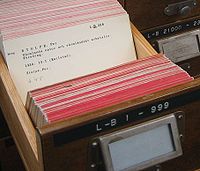
- Optical
- Any objectPhysical bodyIn physics, a physical body or physical object is a collection of masses, taken to be one...
visible to the eye, used to mark a location such as a, stoneRock (geology)In geology, rock or stone is a naturally occurring solid aggregate of minerals and/or mineraloids.The Earth's outer solid layer, the lithosphere, is made of rock. In general rocks are of three types, namely, igneous, sedimentary, and metamorphic...
, flagFlagA flag is a piece of fabric with a distinctive design that is usually rectangular and used as a symbol, as a signaling device, or decoration. The term flag is also used to refer to the graphic design employed by a flag, or to its depiction in another medium.The first flags were used to assist...
or skullSkullThe skull is a bony structure in the head of many animals that supports the structures of the face and forms a cavity for the brain.The skull is composed of two parts: the cranium and the mandible. A skull without a mandible is only a cranium. Animals that have skulls are called craniates...
. - Any craftingArts and craftsArts and crafts comprise a whole host of activities and hobbies that are related to making things with one's hands and skill. These can be sub-divided into handicrafts or "traditional crafts" and "the rest"...
material used to form shapes such as clayClayClay is a general term including many combinations of one or more clay minerals with traces of metal oxides and organic matter. Geologic clay deposits are mostly composed of phyllosilicate minerals containing variable amounts of water trapped in the mineral structure.- Formation :Clay minerals...
, woodWoodWood is a hard, fibrous tissue found in many trees. It has been used for hundreds of thousands of years for both fuel and as a construction material. It is an organic material, a natural composite of cellulose fibers embedded in a matrix of lignin which resists compression...
, metalMetalA metal , is an element, compound, or alloy that is a good conductor of both electricity and heat. Metals are usually malleable and shiny, that is they reflect most of incident light...
, glassGlassGlass is an amorphous solid material. Glasses are typically brittle and optically transparent.The most familiar type of glass, used for centuries in windows and drinking vessels, is soda-lime glass, composed of about 75% silica plus Na2O, CaO, and several minor additives...
, waxWaxthumb|right|[[Cetyl palmitate]], a typical wax ester.Wax refers to a class of chemical compounds that are plastic near ambient temperatures. Characteristically, they melt above 45 °C to give a low viscosity liquid. Waxes are insoluble in water but soluble in organic, nonpolar solvents...
or quipuQuipuQuipus or khipus were recording devices used in the Inca Empire and its predecessor societies in the Andean region. A quipu usually consisted of colored, spun, and plied thread or strings from llama or alpaca hair. It could also be made of cotton cords...
. - Any hard surface that could hold carvingCarving- Arts :*Bone carving*Chip carving*Gourd carving or Gourd art*Ice carving or Ice sculpture*Ivory carving*Stone carving**Petroglyph*Vegetable carving*Wood carving- Others :*Data carving and/or file carving, two closely related data recovery techniques...
s. - Any branding surface that would scar under intense heat (chiefly for livestockLivestock brandingLivestock branding is a technique for marking livestock so as to identify the owner. Originally, livestock branding only referred to a hot brand for large stock, though the term is now also used to refer to other alternative techniques such as freeze branding...
or humansHuman brandingHuman branding or stigmatizing is the process in which a mark, usually a symbol or ornamental pattern, is burned into the skin of a living person, with the intention that the resulting scar makes it permanent. This is performed using a hot or very cold branding iron...
). - Any marking substance such as paintPaintPaint is any liquid, liquefiable, or mastic composition which after application to a substrate in a thin layer is converted to an opaque solid film. One may also consider the digital mimicry thereof...
, inkInkInk is a liquid or paste that contains pigments and/or dyes and is used to color a surface to produce an image, text, or design. Ink is used for drawing and/or writing with a pen, brush, or quill...
or chalkChalkChalk is a soft, white, porous sedimentary rock, a form of limestone composed of the mineral calcite. Calcite is calcium carbonate or CaCO3. It forms under reasonably deep marine conditions from the gradual accumulation of minute calcite plates shed from micro-organisms called coccolithophores....
. - Any surface that would hold a marking substance such as, papyrusPapyrusPapyrus is a thick paper-like material produced from the pith of the papyrus plant, Cyperus papyrus, a wetland sedge that was once abundant in the Nile Delta of Egypt....
, paperPaperPaper is a thin material mainly used for writing upon, printing upon, drawing or for packaging. It is produced by pressing together moist fibers, typically cellulose pulp derived from wood, rags or grasses, and drying them into flexible sheets....
, skinSkin-Dermis:The dermis is the layer of skin beneath the epidermis that consists of connective tissue and cushions the body from stress and strain. The dermis is tightly connected to the epidermis by a basement membrane. It also harbors many Mechanoreceptors that provide the sense of touch and heat...
.
- Any object
- Chemical
- RNARNARibonucleic acid , or RNA, is one of the three major macromolecules that are essential for all known forms of life....
- DNADNADeoxyribonucleic acid is a nucleic acid that contains the genetic instructions used in the development and functioning of all known living organisms . The DNA segments that carry this genetic information are called genes, but other DNA sequences have structural purposes, or are involved in...
- PheromonePheromoneA pheromone is a secreted or excreted chemical factor that triggers a social response in members of the same species. Pheromones are chemicals capable of acting outside the body of the secreting individual to impact the behavior of the receiving individual...
- RNA
Modern examples by energy used

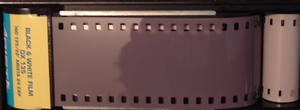
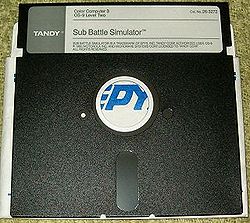

- Chemical
- DipstickDipstickA dipstick is one of several measurement devices.Some dipsticks are dipped into a liquid to perform a chemical test or to provide a measure of quantity of the liquid....
- Dipstick
- Thermodynamic
- ThermometerThermometerDeveloped during the 16th and 17th centuries, a thermometer is a device that measures temperature or temperature gradient using a variety of different principles. A thermometer has two important elements: the temperature sensor Developed during the 16th and 17th centuries, a thermometer (from the...
- Thermometer
- Photochemical
- Photographic filmPhotographic filmPhotographic film is a sheet of plastic coated with an emulsion containing light-sensitive silver halide salts with variable crystal sizes that determine the sensitivity, contrast and resolution of the film...
- Photographic film
- MechanicalClassical mechanicsIn physics, classical mechanics is one of the two major sub-fields of mechanics, which is concerned with the set of physical laws describing the motion of bodies under the action of a system of forces...
- Pins and holes
- PaperPaper data storagePaper data storage refers to the use of paper as a data storage device. This includes writing, illustrating, and the use of data that can be interpreted by a machine or is the result of the functioning of a machine...
- Punched cardPunched cardA punched card, punch card, IBM card, or Hollerith card is a piece of stiff paper that contains digital information represented by the presence or absence of holes in predefined positions...
- Paper tape
- Music rollMusic rollA music roll is a storage medium used to operate a mechanical musical instrument. They are used for the player piano, mechanical organ, electronic carillon and various types of orchestrion. The vast majority of music rolls are made of paper...
- Music roll
- Punched card
- Music box cylinder or disk
- Paper
- Grooves (See also Audio Data)
- Phonograph cylinderPhonograph cylinderPhonograph cylinders were the earliest commercial medium for recording and reproducing sound. Commonly known simply as "records" in their era of greatest popularity , these cylinder shaped objects had an audio recording engraved on the outside surface which could be reproduced when the cylinder was...
- Gramophone recordGramophone recordA gramophone record, commonly known as a phonograph record , vinyl record , or colloquially, a record, is an analog sound storage medium consisting of a flat disc with an inscribed, modulated spiral groove...
- DictabeltDictabeltThe Dictabelt or Memobelt was a form of recording medium introduced by the American Dictaphone company in 1947. It used a type of "Write Once - Read Many" medium consisting of a thin, plastic belt 3.5" wide that was placed on a cylinder and spun like a tank tread. The needle would then move slowly...
(groove on plastic belt) - Capacitance Electronic Disc
- Phonograph cylinder
- Pins and holes
- Magnetic storageMagnetic storageMagnetic storage and magnetic recording are terms from engineering referring to the storage of data on a magnetized medium. Magnetic storage uses different patterns of magnetization in a magnetizable material to store data and is a form of non-volatile memory. The information is accessed using...
- Wire recordingWire recordingWire recording is a type of analog audio storage in which a magnetic recording is made on thin steel or stainless steel wire.The wire is pulled rapidly across a recording head which magnetizes each point along the wire in accordance with the intensity and polarity of the electrical audio signal...
(stainless steel wire) - Magnetic tapeMagnetic tapeMagnetic tape is a medium for magnetic recording, made of a thin magnetizable coating on a long, narrow strip of plastic. It was developed in Germany, based on magnetic wire recording. Devices that record and play back audio and video using magnetic tape are tape recorders and video tape recorders...
- Drum memoryDrum memoryDrum memory is a magnetic data storage device and was an early form of computer memory widely used in the 1950s and into the 1960s, invented by Gustav Tauschek in 1932 in Austria....
(magnetic drum) - Floppy diskFloppy diskA floppy disk is a disk storage medium composed of a disk of thin and flexible magnetic storage medium, sealed in a rectangular plastic carrier lined with fabric that removes dust particles...
- Wire recording
- Optical storageOptical storageOptical storage is a term from engineering referring to the storage of data on an optically readable medium. Data is recorded by making marks in a pattern that can be read back with the aid of light, usually a beam of laser light precisely focused on a spinning disc. An older example, that does...
- Optical jukeboxOptical jukeboxAn optical jukebox is a robotic data storage device that can automatically load and unload optical discs, such as Compact Disc, DVD, Ultra Density Optical or Blu-ray disc and can provide terabytes and petabytes of tertiary storage. The devices are often called optical disk libraries, robotic...
- Photographic paperPhotographic paperPhotographic paper is paper coated with light-sensitive chemicals, used for making photographic prints.Photographic paper is exposed to light in a controlled manner, either by placing a negative in contact with the paper directly to produce a contact print, by using an enlarger in order to create a...
- X-rayX-rayX-radiation is a form of electromagnetic radiation. X-rays have a wavelength in the range of 0.01 to 10 nanometers, corresponding to frequencies in the range 30 petahertz to 30 exahertz and energies in the range 120 eV to 120 keV. They are shorter in wavelength than UV rays and longer than gamma...
- MicroformMicroformMicroforms are any forms, either films or paper, containing microreproductions of documents for transmission, storage, reading, and printing. Microform images are commonly reduced to about one twenty-fifth of the original document size...
- Hologram
- ProjectedOverhead projectorAn overhead projector is a variant of slide projector that is used to display images to an audience.-Mechanism:An overhead projector typically consists of a large box containing a very bright lamp and a fan to cool it. On top of the box is a large fresnel lens that collimates the light...
foilTransparency (projection)A transparency, also known in industrial settings as a "viewfoil" or "foil", is a thin sheet of transparent flexible material, typically cellulose acetate, onto which figures can be drawn. These are then placed on an overhead projector for display to an audience... - Optical discOptical discIn computing and optical disc recording technologies, an optical disc is a flat, usually circular disc which encodes binary data in the form of pits and lands on a special material on one of its flat surfaces...
- Magneto-optical driveMagneto-optical driveA magneto-optical drive is a kind of optical disc drive capable of writing and rewriting data upon a magneto-optical disc. Both 130 mm and 90 mm form factors exist. The technology was introduced commercially in 1985...
- Holographic data storageHolographic data storageHolographic data storage is a potential technology in the area of high-capacity data storage currently dominated by magnetic and conventional optical data storage. Magnetic and optical data storage devices rely on individual bits being stored as distinct magnetic or optical changes on the surface...
- 3D optical data storage3D optical data storage3D optical data storage is the term given to any form of optical data storage in which information can be recorded and/or read with three dimensional resolution ....
- Optical jukebox
- Electrical
- SemiconductorSemiconductorA semiconductor is a material with electrical conductivity due to electron flow intermediate in magnitude between that of a conductor and an insulator. This means a conductivity roughly in the range of 103 to 10−8 siemens per centimeter...
used in volatileVolatile memoryVolatile memory, also known as volatile storage, is computer memory that requires power to maintain the stored information, unlike non-volatile memory which does not require a maintained power supply...
random-access memoryRandom-access memoryRandom access memory is a form of computer data storage. Today, it takes the form of integrated circuits that allow stored data to be accessed in any order with a worst case performance of constant time. Strictly speaking, modern types of DRAM are therefore not random access, as data is read in... - Floating-gate transistor used in non-volatile memory cardMemory cardA memory card or flash card is an electronic flash memory data storage device used for storing digital information. They are commonly used in many electronic devices, including digital cameras, mobile phones, laptop computers, MP3 players, and video game consoles...
s
- Semiconductor
Modern examples by shape
A typical way to classify data storage media is to consider its shape and type of movement (or non-movement) relative to the read/write device(s) of the storage apparatus as listed:- Paper card storage
- Punched cardPunched cardA punched card, punch card, IBM card, or Hollerith card is a piece of stiff paper that contains digital information represented by the presence or absence of holes in predefined positions...
(mechanical)
- Punched card
- Cams and tracers (pipe organ combination-action memory memorizing stop selections)
- Tape storage (long, thin, flexible, linearly moving bands)
- Paper tapePunched tapePunched tape or paper tape is an obsolete form of data storage, consisting of a long strip of paper in which holes are punched to store data...
(mechanical) - Magnetic tapeMagnetic tapeMagnetic tape is a medium for magnetic recording, made of a thin magnetizable coating on a long, narrow strip of plastic. It was developed in Germany, based on magnetic wire recording. Devices that record and play back audio and video using magnetic tape are tape recorders and video tape recorders...
(a tape passing one or more read/write/erase heads)
- Paper tape
- Disk storageDisk storageDisk storage or disc storage is a general category of storage mechanisms, in which data are digitally recorded by various electronic, magnetic, optical, or mechanical methods on a surface layer deposited of one or more planar, round and rotating disks...
(flat, round, rotating object)- Gramophone recordGramophone recordA gramophone record, commonly known as a phonograph record , vinyl record , or colloquially, a record, is an analog sound storage medium consisting of a flat disc with an inscribed, modulated spiral groove...
(used for distributing some 1980s home computer programs) (mechanical) - Floppy diskFloppy diskA floppy disk is a disk storage medium composed of a disk of thin and flexible magnetic storage medium, sealed in a rectangular plastic carrier lined with fabric that removes dust particles...
, ZIP diskZip driveThe Zip drive is a medium-capacity removable disk storage system that was introduced by Iomega in late 1994. Originally, Zip disks launched with capacities of 100 MB, but later versions increased this to first 250 MB and then 750 MB....
(removable) (magnetic) - HolographicHDSSIn late 1995 a joint university, industry and government consortium initiated the Holographic Data Storage System programme, with the initial goals of developing several key components for the system, including a high-capacity, high-bandwidth spatial light modulator used for data input; optimised...
- Optical discOptical discIn computing and optical disc recording technologies, an optical disc is a flat, usually circular disc which encodes binary data in the form of pits and lands on a special material on one of its flat surfaces...
such as CD, DVDDVDA DVD is an optical disc storage media format, invented and developed by Philips, Sony, Toshiba, and Panasonic in 1995. DVDs offer higher storage capacity than Compact Discs while having the same dimensions....
, Blu-ray DiscBlu-ray DiscBlu-ray Disc is an optical disc storage medium designed to supersede the DVD format. The plastic disc is 120 mm in diameter and 1.2 mm thick, the same size as DVDs and CDs. Blu-ray Discs contain 25 GB per layer, with dual layer discs being the norm for feature-length video discs... - MinidiscMiniDiscThe disc is permanently housed in a cartridge with a sliding door, similar to the casing of a 3.5" floppy disk. This shutter is opened automatically by a mechanism upon insertion. The audio discs can either be recordable or premastered. Recordable MiniDiscs use a magneto-optical system to record...
- Hard disk drive (magnetic)
- Gramophone record
- Magnetic bubble memory
- Flash memoryFlash memoryFlash memory is a non-volatile computer storage chip that can be electrically erased and reprogrammed. It was developed from EEPROM and must be erased in fairly large blocks before these can be rewritten with new data...
/memory cardMemory cardA memory card or flash card is an electronic flash memory data storage device used for storing digital information. They are commonly used in many electronic devices, including digital cameras, mobile phones, laptop computers, MP3 players, and video game consoles...
(solid state semiconductor memorySemiconductor memorySemiconductor memory is an electronic data storage device, often used as computer memory, implemented on a semiconductor-based integrated circuit. Examples of semiconductor memory include non-volatile memory such as Read-only memory , magnetoresistive random access memory , and flash memory...
)- xD-Picture CardXD-Picture CardxD-Picture Card is a flash memory card format, used mainly in older digital cameras. xD stands for Extreme Digital.xD cards are available in capacities of 16 MiB up to 2 GiB.- History :...
- MultiMediaCardMultiMediaCardThe MultiMediaCard is a flash memory memory card standard. Unveiled in 1997 by Siemens AG and SanDisk, it is based on Toshiba's NAND-based flash memory, and is therefore much smaller than earlier systems based on Intel NOR-based memory such as CompactFlash. MMC is about the size of a postage...
- USBUniversal Serial BusUSB is an industry standard developed in the mid-1990s that defines the cables, connectors and protocols used in a bus for connection, communication and power supply between computers and electronic devices....
flash driveUSB flash driveA flash drive is a data storage device that consists of flash memory with an integrated Universal Serial Bus interface. flash drives are typically removable and rewritable, and physically much smaller than a floppy disk. Most weigh less than 30 g...
(also known as a "thumb drive" or "keydrive") - SmartMediaSmartMediaSmartMedia is a flash memory card standard owned by Toshiba, with capacities ranging from 2 MB to 128 MB. SmartMedia memory cards are no longer manufactured.- History :...
- CompactFlashCompactFlashCompactFlash is a mass storage device format used in portable electronic devices. Most CompactFlash devices contain flash memory in a standardized enclosure. The format was first specified and produced by SanDisk in 1994...
I and II - Secure DigitalSecure Digital cardSecure Digital is a non-volatile memory card format developed by the SD Card Association for use in portable devices. The SD technology is used by more than 400 brands across dozens of product categories and more than 8,000 models, and is considered the de-facto industry standard.Secure Digital...
- Sony Memory StickMemory StickMemory Stick is a removable flash memory card format, launched by Sony in October 1998, and is also used in general to describe the whole family of Memory Sticks...
(Std/Duo/PRO/MagicGate versions) - Solid-state driveSolid-state driveA solid-state drive , sometimes called a solid-state disk or electronic disk, is a data storage device that uses solid-state memory to store persistent data with the intention of providing access in the same manner of a traditional block i/o hard disk drive...
- xD-Picture Card
Bekenstein (2003) foresees that miniaturization might lead to the invention of devices that store bit
Bit
A bit is the basic unit of information in computing and telecommunications; it is the amount of information stored by a digital device or other physical system that exists in one of two possible distinct states...
s on a single atom
Atom
The atom is a basic unit of matter that consists of a dense central nucleus surrounded by a cloud of negatively charged electrons. The atomic nucleus contains a mix of positively charged protons and electrically neutral neutrons...
.
Weight and volume
Especially for carrying around data, the weight and volume per MB are relevant. They are quite large for written and printed paper compared with modern electronic media. On the other hand, written and printer paper do not require (the weight and volume of) reading equipment, and handwritten edits only require simple writing equipment, such as a penPen
A pen is a device used to apply ink to a surface, usually paper, for writing or drawing. Historically, reed pens, quill pens, and dip pens were used, with a nib of some sort to be dipped in the ink. Ruling pens allow precise adjustment of line width, and still find a few specialized uses, but...
.
With mobile data connections the data need not be carried around to have them available.
External links
- Historical Notes about the Cost of Hard Drive Storage Space
- Macroscopic 10-Terabit–per–Square-Inch Arrays from Block Copolymers with Lateral Order - Science magazine article about perspective usage of sapphire in digital storage media technology

